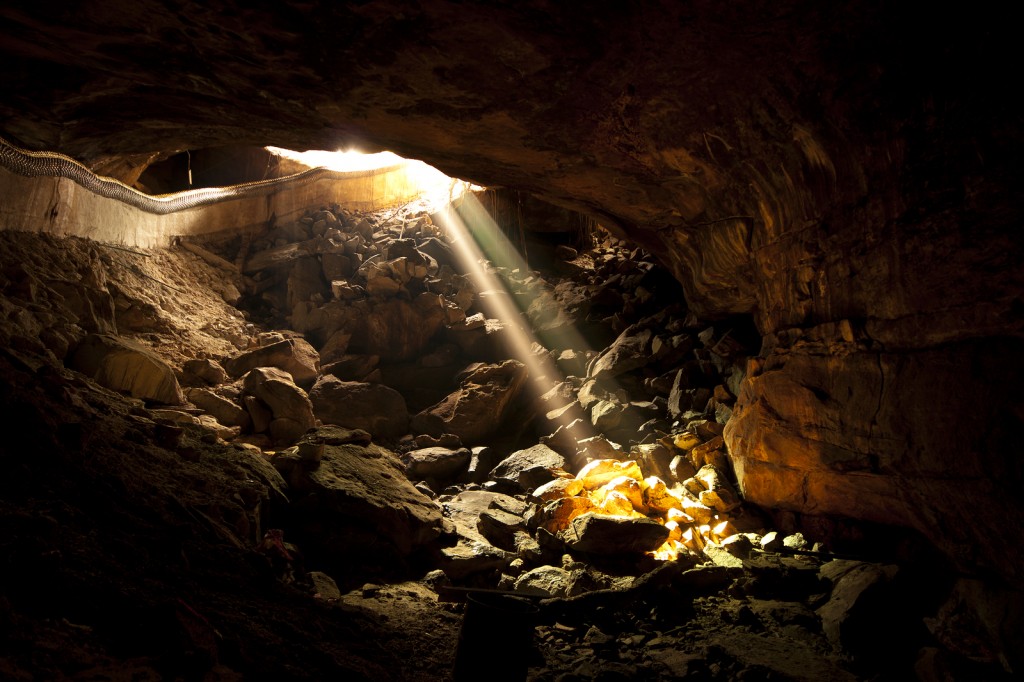DREAM BIG said the T-shirt of a man I was following into the woods of Oak Island. The motto could not be more fitting – it takes a dreamer to relentlessly pursue a treasure which no one has been able to find in the last 219 years. As I take in the dark green beauty of the forest and the white capped sea, I listen … There is a secret here, but it’s hidden, wrapped in the layers of time, sealed with the intent of the mysterious depositors. When the French explorer Samuel de Champlain left out Mahone Bay from his otherwise meticulous map of Nova Scotia, was he too protecting its secret?
The group of 60-some people, dogs and strollers moves on and I have no choice but to follow. I wish I had signed up for the morning tour – the weather is hot and were it not for the occasional breeze it would be unbearable. Our guides are local Maritimers used to anything nature can throw at them, and they lead us to every important rock and hole, diligently narrating the history of the island and its unfortunate treasure seekers.
What started as a quick excavation with shovels by three youngsters in 1795 evolved into a technologically sophisticated treasure hunt involving drills, augers, hydraulic pumps, ground penetrating radar, underwater scans and electric pulses, all to naught. What works elsewhere does not always yield the same results on Oak Island – it’s as if the island had superpowers that foil modern technology.
As much as I wished to know what was hidden there, I couldn’t help but root for the island. It’s like a pet that wants to be cared for, not probed. I hugged an oak tree when no one was looking.
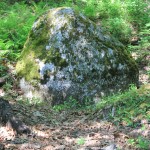
Oak trees … Do acorns float? Or had someone planted red oaks here as a secret sign to be recognized by the initiated? I couldn’t help but notice that the famous Money Pit was located on the side facing the open ocean. It was only too easy to imagine Spanish ships, loaded with Inca gold, making a stop in one of the coves to skim a percentage off the booty, squirreling it away. They had the motive, the men and the time to do it. But could they have been so sophisticated as to incorporate the island’s geological and chemical properties (lime stone, caves, chlorine gas) to create a perfect booby trap?

We sweated profusely as we climbed up a slope to gaze upon a 160-feet deep hole filled with murky yellow water – the Money Pit. The collective silence was punctuated by the merry sounds of industrious insects selecting the juiciest human to land on. “Don’t step too close!” the guards warned, and everyone took a precautionary step back. As much as we were dying to know what lies at the bottom of the pit, no one was volunteering to become the Money Pit’s next victim.
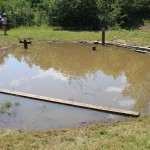
I studied the sign describing in detail what kind of organic materials had been removed from the pit: oak, putty, clay, coconut fibre … The best clues to the origins of the pit, they had been discarded by eager diggers who only had gold on their minds. Fortunately, coconut fibre found in abundance beneath the rocky beach in Smith’s Cove was submitted to various reputable institutions for carbon dating. The results were staggering: 1100s-1300s, with the years 1229 or 1278 as medians.
To the naysayers who argue the coconut fibre floated here from the Caribbean during hurricanes: it was also found inside the Money Pit.
Who on earth was traveling to Nova Scotia in that time period? Vikings undertook ocean voyages between Greenland and Newfoundland between 1000 and 1347. While they had a presence here they lacked the motive. They also did not possess the kind of riches that would warrant an extensive operation such as this. One European group did – if we are talking Europeans – the Knights Templar.
A wealthy and powerful monastic order, the Knights Templar met with a tragic end initiated by King Philip IV, who owed them huge sums of money. Philip had planned their arrest ever so carefully, instructing his henchmen to open their orders the night before October 13th, 1307. But the clever Templars had friends in high places and sent their treasury away in the nick of time. To Switzerland, to Scotland … No one knows.
Could they have sailed to Nova Scotia? I think so. A transatlantic journey was not a feat only Vikings were capable of. We know that Basque fishermen were familiar with Newfoundland’s Grand Banks in the 1500s, if not earlier. But in history it’s not the Sherpa who gets credited with reaching the highest mountain or some poor fisherman with venturing to the place marked as Here be Dragons on the map. No, history reserves such honor to men of importance. The Order of the Knights Templar was once of prominence, but in 1307 its members were on the run.
The Order was as mysterious as Oak Island. Rumored to possess the Ark of the Covenant and the Grail, it seemed to have come to a great wealth of knowledge channeled into the construction of Gothic cathedrals. In The Mysteries of Chartres Cathedral, Louis Charpentier ponders the question of finance: “But money, rare until towards 1100, became more plentiful towards the end of the Middle Ages … Where did it come from? The German mines were then unknown, those of Gaul exhausted or lost, the Russian ones still unprospected.” (1) He goes on to suggest the precious metals came from New World: “… the Temple went looking for gold from the Mexican mines, and that this money was then concentrated at Sours … command post near Chartres.” (2)
To delve even deeper into history, it is perhaps no coincidence that famous Portuguese navigators hailed from the Order of Christ, which had taken under its protection the disenfranchised Templar knights. In Spain, the knights had found sanctuary in the Order of Calatrava in whose monastery Christopher Columbus, the designated discoverer of New World, spent some time …
I sidled up to our tour guide, a relative of the Blankeship family, and asked him who had built the flood tunnels bringing in seawater from Smith’s Cove into the Money Pit. “Templars.” I nodded and posed another question – how did they plan to retrieve the treasure? The guide adjusted his hat and admitted he did not know, but he used a good analogy to explain the booby trap mechanism: If you put a finger on top of a straw and submerge it in a glass of water, the air inside the straw will keep the water out. Remove the finger and the pressure evens out, causing the straw the fill with water. The impatient treasure seekers had removed the imaginary finger by excavating the layers of the Money Pit.
How do you pump out the ocean?
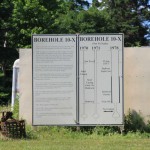
Toward the end of the tour we met Rick Lagina, one of the American brothers from History Channel’s riveting show The Curse of Oak Island. He was amiable and posed for photos, then answered questions about Season 2. I turned to an 11-year old girl who had come here with her mother all the way from New Brunswick. She had read a book about Oak Island and wanted to see it with her own eyes. I smiled and asked her who she thought had done it. “Spaniards.”
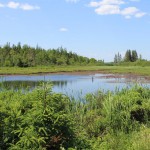
Vikings, Templars, Spaniards, Captain Kidd … Take your pick. With one last look at its silent forest I took my leave of Oak Island, hoping the owners would continue to respect it and treasure it not for the gold, Shakespeare’s original plays, records of Jesus’ bloodline etc supposedly stored in its underground vault, but for the coastal gem it is.
P.S. I can’t wait to see Season 2 of The Curse of Oak Island, right after Season 3 of Vikings.
References:
(1) Charpentier, Louis (1975) ‘The Mysteries of Chartres Cathedral’, ppg 174-175.
(2) Charpentier, Louis (1975) ‘The Mysteries of Chartres Cathedral’, ppg 174.
